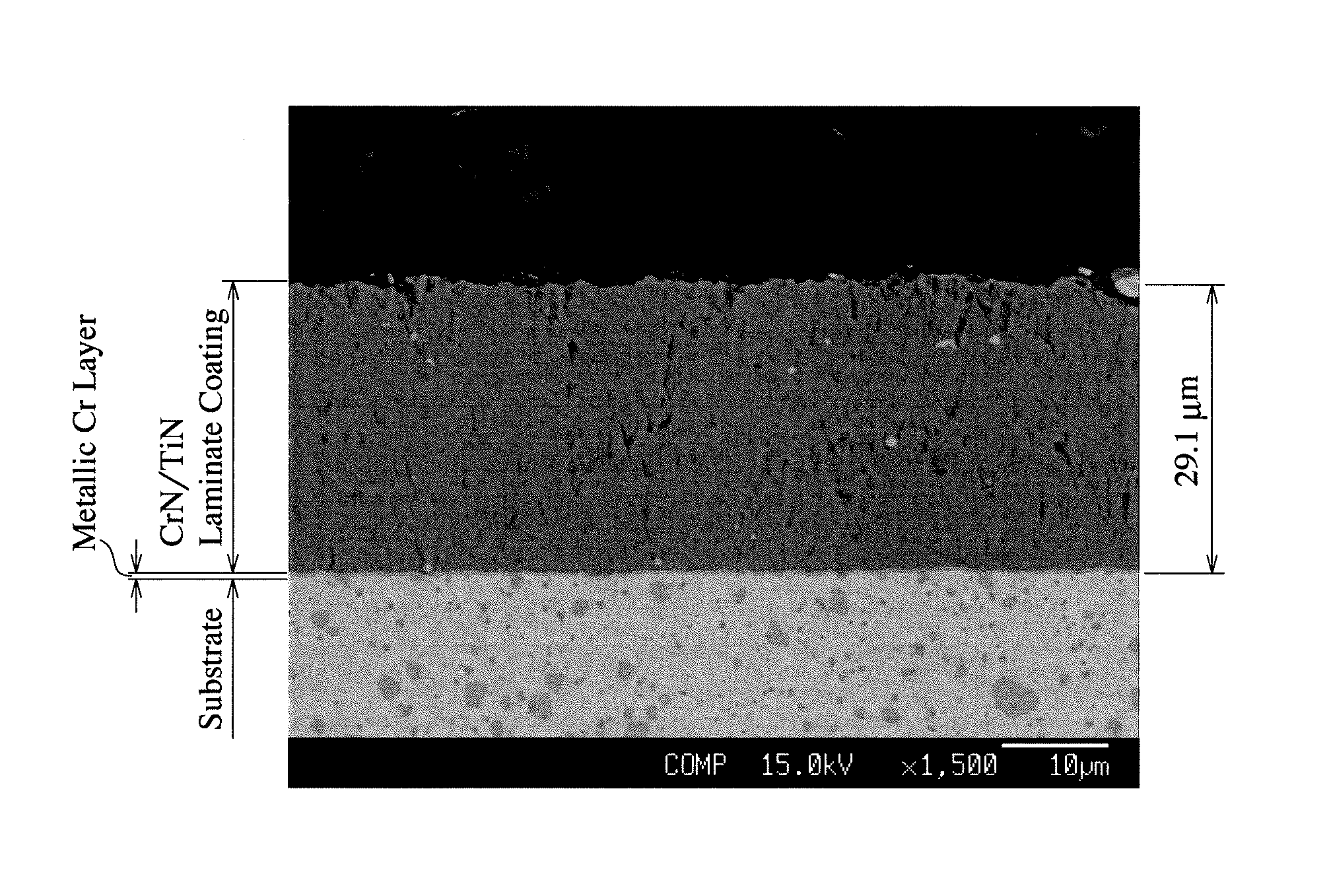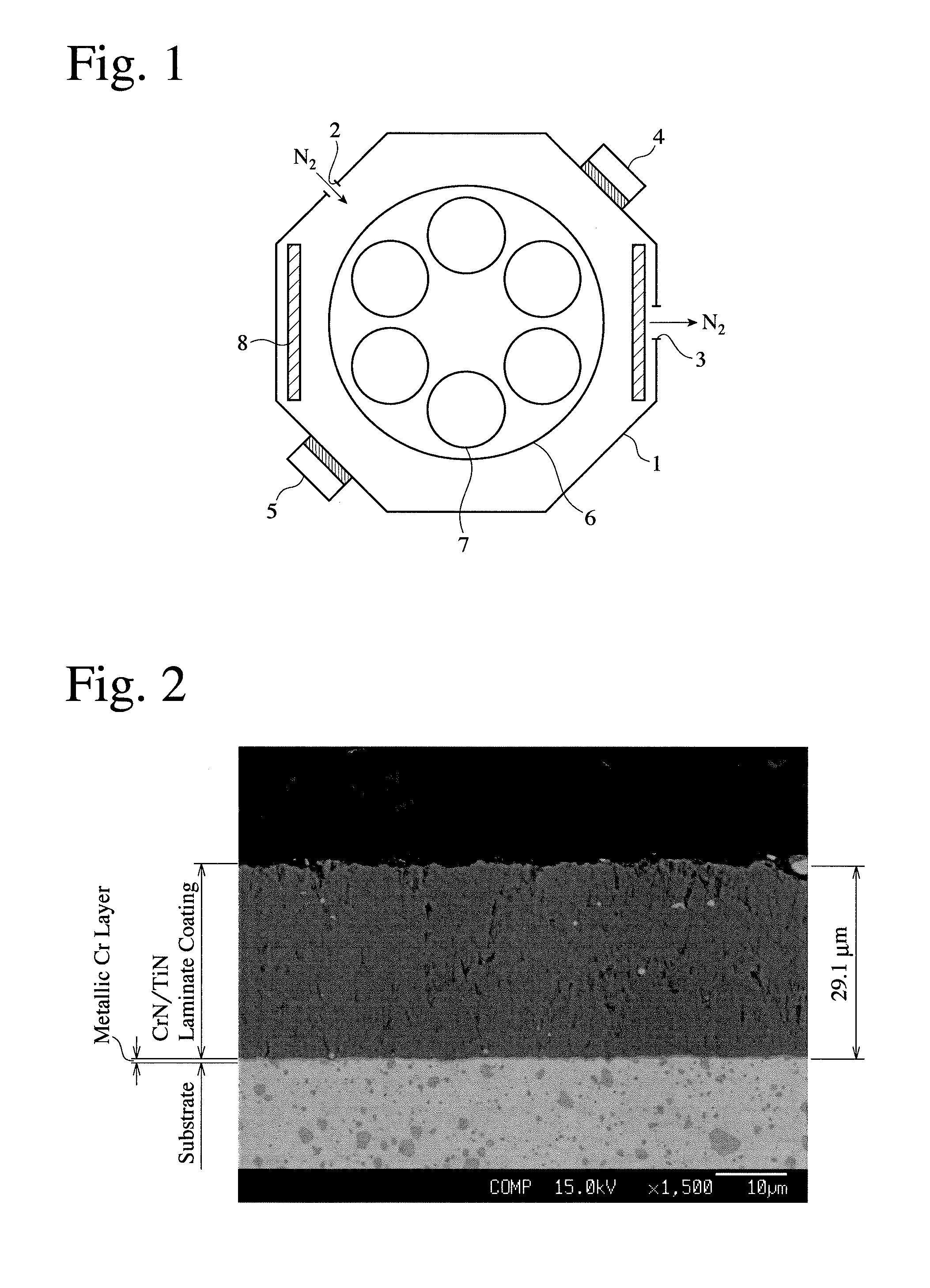Piston ring
a technology of piston rings and rings, applied in the field of piston rings, can solve the problems of insufficient performance and adverse effect on scuffing resistance, and achieve the effects of excellent scuffing resistance, wear resistance and peeling resistan
- Summary
- Abstract
- Description
- Claims
- Application Information
AI Technical Summary
Benefits of technology
Problems solved by technology
Method used
Image
Examples
example 1
[0043]Piston rings each having a rectangular cross section and a barrel-faced outer peripheral surface [nominal diameter (d): 96 mm, thickness (al): 3.8 mm, and width (h1): 2.5 mm] were formed from a wire of SWOSC-V, and 50 piston rings were stacked, shot-blasted on their outer peripheral surfaces to surface roughness (Ry) of several μm, and set in an arc ion plating apparatus (AIP-S40 available from Kobe Steel, Ltd.), which had a target of 99.9-%-pure metallic chromium and a target of 99.9-%-pure metallic titanium. After evacuating the apparatus to 1.0×10−2 Pa, outer peripheral surfaces of the piston rings as substrates were cleaned by a bombardment treatment, with an Ar gas introduced up to 1.0 Pa, and bias voltage of −600 V to −1000 V applied. The Ar gas was 99.99% pure. Thereafter, with a 99.999-%-pure N2 gas introduced up to 4 Pa, ion plating was conducted for 400 minutes, at arc current of 120 A for the metallic chromium cathode, arc current of 170 A for the metallic titanium ...
examples 2-8
[0057]In Examples 2-8, ion plating was conducted under the film-forming conditions shown in Table 1, which also shows the film-forming conditions in Example 1. In Example 2, a lower partial pressure of N2 than in Example 1 was used. In Example 3, a ratio of chromium to titanium was changed by changing arc current applied to the metallic chromium cathode and the metallic titanium cathode, and larger bias voltage than in Example 1 was used. In Examples 4 and 5, the number of rotation of the table was smaller than in Example 1 to change the thickness of a unit laminate. In Example 6, arc current applied to the metallic chromium cathode and the bias voltage were larger than in Example 4. In Example 7, the bias voltage was larger than in Examples 3 and 6. In Example 8, the bias voltage was smaller than in Example 3.
TABLE 1Film-ArcPartialBiasRotationFormingCurrent (A)Pressure ofVoltageof TableTimeNo.CrTiN2 (Pa)(V)(rpm)(minute)Example 11201704−92400Example 21201702.7−92370Example 31601304−...
examples 9-10
[0061]Ion plating was conducted in the same manner as in Example 1, except for changing the arc-ion-plating cathodes to the same metallic chromium cathode as in Example 1 and a 99.7-%-pure metallic zirconium cathode (Example 9), and to the same metallic chromium cathode as in Example 1 and a titanium-aluminum alloy (50 atomic % Ti-50 atomic % Al alloy) cathode (Example 10), thereby forming a CrN / ZrN laminate coating in Example 9 and a CrN / TiAlN laminate coating in Example 10 on piston rings. The arc current was 120 A at the metallic chromium cathode, 170 A at the metallic zirconium cathode, and 170 A at the titanium-aluminum cathode.
PUM
| Property | Measurement | Unit |
|---|---|---|
| thick | aaaaa | aaaaa |
| thickness | aaaaa | aaaaa |
| crystallite size | aaaaa | aaaaa |
Abstract
Description
Claims
Application Information
 Login to View More
Login to View More - R&D
- Intellectual Property
- Life Sciences
- Materials
- Tech Scout
- Unparalleled Data Quality
- Higher Quality Content
- 60% Fewer Hallucinations
Browse by: Latest US Patents, China's latest patents, Technical Efficacy Thesaurus, Application Domain, Technology Topic, Popular Technical Reports.
© 2025 PatSnap. All rights reserved.Legal|Privacy policy|Modern Slavery Act Transparency Statement|Sitemap|About US| Contact US: help@patsnap.com



